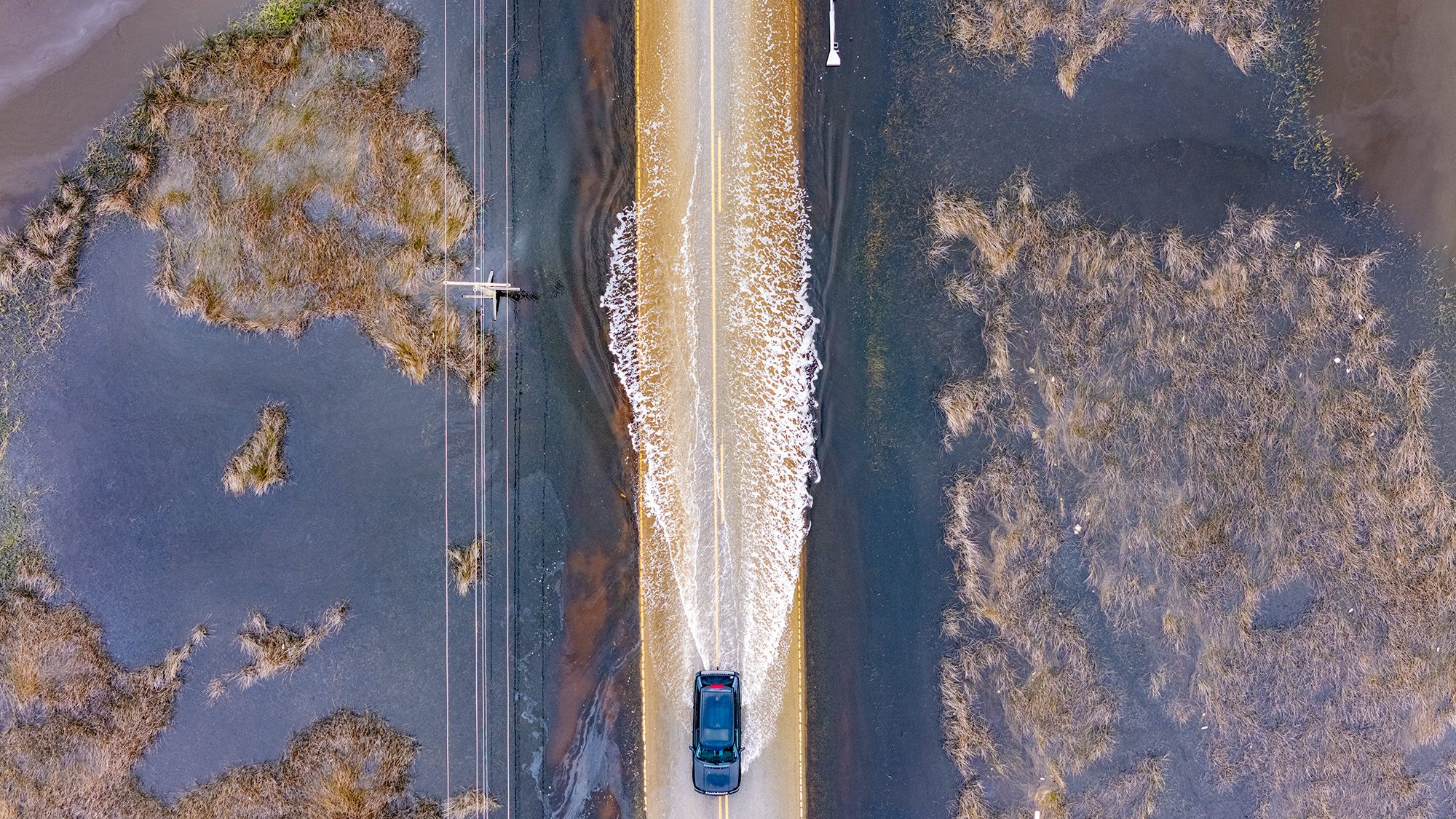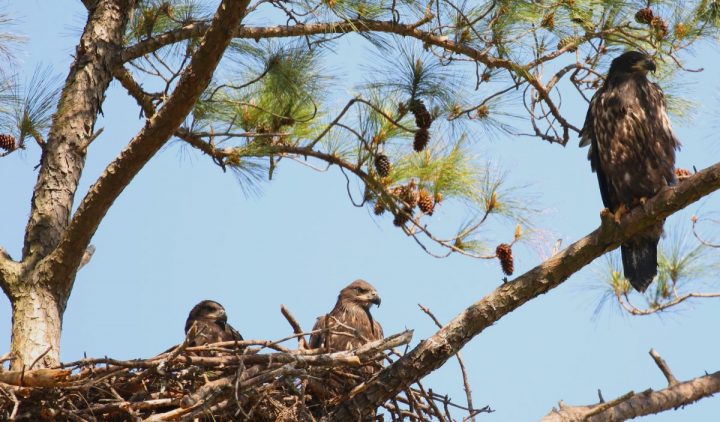
ORIENTAL – My kayak skimmed effortlessly across the smooth glassy waters of a protected channel on a sleepy afternoon near this Pamlico County town. Tall pine trees lining the cut were perfectly reflected on the surface of the water. The images soon became distorted and twisted as if in a house of mirrors as the wake of the boat disturbed the water’s silence. I was off to look for bald eagles after a photographer friend tipped me off to their presence. Last spring, I kayaked these familiar waters in an attempt to find the eagles, but became distracted by a nest of great horned owl chicks.

The stone-lined canal spilled out into an open bay that accepted the flow from a number of different creeks. I pointed my kayak to the east where these estuary waters flood into the lower Neuse River and soon into the Pamlico Sound. To my right, a thin peninsula protected me from the wind as a jumping mullet escorted my progress. Every few seconds, the mullet would jump, smacking the water with an audible splash. I tried to keep up, but the mullet outpaced me and veered off into deeper water. Preoccupied with the oily fish, I failed to notice a bald eagle and an osprey roosting in a large pine until they both launched into flight and flew in different directions. The eagle was most likely trying to steal a fish away from the osprey, a standard practice. With my camera gear stowed securely in waterproof bags, a photo was unlikely anyway.
Supporter Spotlight
Fearful that I would miss another opportunity, I guided the kayak to the near shore as the chattering of an annoyed kingfisher protested my arrival. Under the branches of a gnarled old live oak tree, I prepared my camera. The wind-stunted oak tree quickly had occupants as a group of five red-winged blackbirds flew in to investigate my presence. With my camera ready, I shoved off and was soon in open water where the creek met the Neuse River. The wind was significant enough to stir up some chop that smacked the kayak broadside. To keep the swells at a more manageable angle, I had to navigate a big V pattern to reach my destination. As I paddled into the waves, an osprey flew low, just above the water, with a large branch in its talons. It landed on a channel marker where it was building a nest over the water in the mouth of the creek.
Paddling across the mouth of the creek, toward the next peninsula, the bald eagle returned and flew a lazy circle over of a section of pines on the peninsula. Mature bald eagles are dark brown to nearly black with a white head and tail feathers. The word “bald” refers to the color white, not the lack of feathers. They are large birds with a seven-foot wing span and can weigh up to 14 pounds. It flew off and landed about a half-mile away on the skeleton of a ghost tree perched on the edge of the river. Alerted to the stand of pines, I took out my binoculars and surveyed the trees. I quickly saw the object of the eagle’s attention, a large, bulky nest high in the tree. This was obviously not an osprey nest. An eagle nest can be five feet wide and, since the pair will use the nest year after year, it can grow up to 10 feet wide and weigh more than a ton. Through the binoculars I could see three heads popping up like periscopes, baby bald eagles.
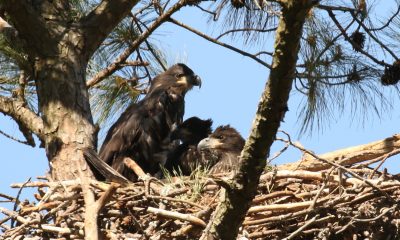
I paddled to the far shore to put distance between myself and the nest tree. Here, under the cover of wax myrtles, I set up my camera outfitted with a telephoto lens and waited. Every now and then, one of the chicks’ heads would peer out for a second or two. Then out of nowhere, an eagle appeared over the pines. It made one loop then flew into the wind, navigating the pine branches, and landed on the side of the nest. The parent was greeted with loud, high-pitched chirping from the chicks. The chicks could now easily be seen as they hopped about and jockeyed for position, waiting for the adult eagle to drop the partially eaten fish firmly gripped in its sharp talons. It was now easy to see that these “chicks” would soon be ready to fledge as they were almost as big as the adult.
After the feeding frenzy, one of the chicks moved out of the cramped nest and onto a nearby branch where it would occasionally open its wings. The young displayed dark brown feathers on the backside and brown and white streaking on the breast and underneath. They will not acquire the iconic plumage of an adult until their sixth year. It appeared that this chick was starting the “branching” phase where they venture out onto branches of the nest tree and exercise their wings with short hover flights. As they gain strength, they may take short flights among the branches before they attempt to fly away from the nest. To inspire their first flight, the adults will land on a tree near the nest, appetizing them with a fish.
After dropping off the fish for the eaglets, the adult flew to the branch of a dead pine tree close to the nest. After a few sharp calls that impaled the surrounding silence, it then flew for a brief stay at two other roosting trees, each time moving farther from the nest. With one last call of dominance, it then flew high into the air and out of sight. All this action lasted for no more than five to 10 minutes. I then settled in to wait for more activity. However, the only action to take my mind off the mosquitos and gnats feasting on my flesh was a pair of killdeer plovers tending to a nest of three eggs on a spit of sand. Then, there was a lone lizard, a Carolina anole, climbing the wax myrtle while displaying its bright red dewlap in a desperate attempt to attract a mate.
Supporter Spotlight
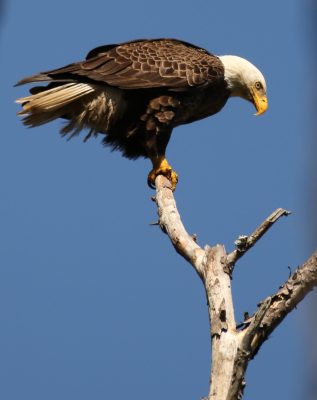
I noticed the eagle chick that was out of the nest and on the branch was always looking in the same direction, rarely surveying the surroundings. I moved out of my shrub blind and looked east down the shoreline. About a half-mile down on a dead snag was one of the adults and another half-mile down was the other parent. Both were on dead trees overlooking the river, hunting for fish. Using their amazing eyesight, the chick was keeping an eye on the parents in anticipation of the next feeding. The eye of an eagle has two areas of focus that allows them to see straight ahead as well as excellent peripheral vision. They can spot prey a mile away and as they gain elevation they can see even farther.
Native to only North America, bald eagle numbers were once thought to be close to half a million birds prior to colonization. They occupied the east and west coastlines and all the major rivers and large lakes throughout the U.S. However, by 1963 there were only 417 nesting pairs left in the lower 48 states. Declared an endangered species in most of the United States in 1967, this raptor has made a steady comeback from its decline that resulted from loss of habitat, shootings, poisoning and pesticide ingestion. With public awareness programs and government bans of certain pesticides, the raptor started to recover.
In 1982, the North Carolina Wildlife Resources Commission established the Bald Eagle Project to reintroduce bald eagles in the eastern part of the state. The project was a success with a wild bald eagle nest found in 1984 near Lake Mattamuskeet. Commission biologists continue to conduct surveys to determine the number of nesting pairs in the state. The eagles nest throughout the state with the greatest concentration in the coastal plain and the fewest in the mountains. The most recent surveys conservatively estimate that 48 active nests were located along the coastal areas. In 2007, the bald eagle was removed from the federal list of endangered and threatened species. The birds still benefit from the continued protection of the Bald and Golden Eagle Protection Act and are still listed as a threatened species in North Carolina. Sadly though, these protections can’t stop idiocy. In February, a mature bald eagle was found shot in the head in Chatham County.
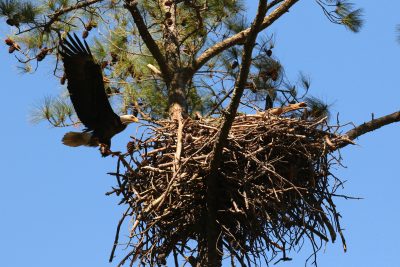
Scientists are still vigilant, learning more about these creatures. North Carolina State University professors Ted Simons and Roland Kays have partnered with wildlife rehabilitation organizations to attach global positioning system, or GPS, transmitters on eagles. Once injured birds are ready for release back into the wild, they fly away with a miniature solar-powered transmitter backpack. Two eagles, a male named Freedom and a female named Yangchen, are providing information about migration, mating and nesting activity. During the past year, Freedom has ventured as far south as Edisto Beach, South Carolina, and as far north as Montreal, Canada, while spending time along the shore of Lake Erie. Yangchen has been less adventurous, sticking to the coastal plain of northeast North Carolina and southern Virginia. Their tracked movements can be viewed by downloading the app “Animal Tracker” on a mobile device.
With the shadows of the trees growing longer, the stillness of the day gave way to a breezy wind that gained strength across the open water. In the golden light of a fading sun, I shoved off into a conspiring wind. As the swells bit the bow of the kayak, a fine mist sprayed into the air, properly soaking me. After about a half-hour of paddling, I turned the boat into a following sea and a generous wind. Soon, I was behind the protection of land and plowed the boat through the placid water. High overhead, I spotted a lone eagle soaring out over the river. The bald eagle has dominated the human conscious for thousands of years. Researchers have found eagle claws where Neanderthals, 130,000 years ago, fashioned them into jewelry, perhaps a necklace of symbolic importance.
I began to think about the Native Americans and their reverence for the bald eagle. They are thought to be spiritual messengers, healers and possess magical powers. In 1782, the fledgling United States selected the bald eagle to represent the nation as its official emblem and it graces the Great Seal of the United States. It is also the national bird, its image printed on money and embossed on a number of official seals. It represents power; strength; truth; integrity; honesty; wisdom; vision; and freedom. We use the image of the eagle in hopes that these virtues will represent what we want to see in ourselves. We must continue to protect the eagle and all wildlife so that the children of future generations can nourish their growing spirit with the wildness of this great earth.
Tired from paddling, I leaned back and let the kayak drift. Looking into the clear blue skies, the eagle soared on a thermal as the lyrics of a favorite old song began to sing in my head:
Above the ridge an eagle flies
In lazy circles in the western skies
I want to fly with him
I want to walk the spirit trail
— Dan Fogelberg, “Spirit Trail”






